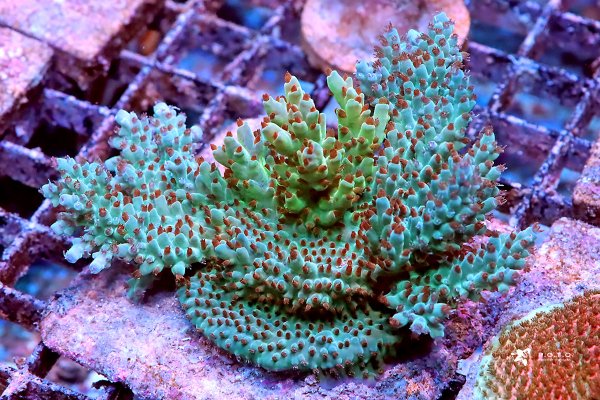One of the best parts about the reefing hobby is collecting your favorite corals and watching them grow from small frags into colonies. Each reefer has the potential to grow corals and share their frags with others. That's the essence of the reefing hobby. Here at POTO, we are grateful to be able to do it on a large scale.
This article focuses on the genus Acropora, as it is the most coveted and demanding coral in the reefing hobby.
Corals lack the meaningful features commonly associated with animals, and are considered a simple life form that is 95% water. This can lead us to downplay the fact that they are in essence animals with complex biological and chemical processes. They can adapt to environmental changes, and can also suffer from them. To understand the concept of captive-growing these creatures, we must first recognize this fact.
All corals in the hobby at one point came from the ocean. And when they were first collected, the coral had been living in an environment that remained virtually unchanged over decades if not centuries. Talk about stability.
When a coral is collected, its entire world is turned upside down. It goes through multiple stewardships for days to a week in transport and holding. By the time it gets into a hobbyist's hand, the harshest part is just beginning. They are exposed to dipping, handling and, more often than not, unstable parameters, on top of potential diseases and parasites.
Corals are engineered to survive in harsh conditions by evolution over millions of years. Although the handling and transport can be harsh, if done right, most corals acclimate to captivity well. And it is through this process that corals start to distinguish themselves into categories of hardiness.
Adaptation is a strong characteristic of corals. Have you seen or heard of a coral that sit dormant months and years on end until suddenly it takes off? It is sitting and waiting for favorable conditions before it decides it is safe to grow.
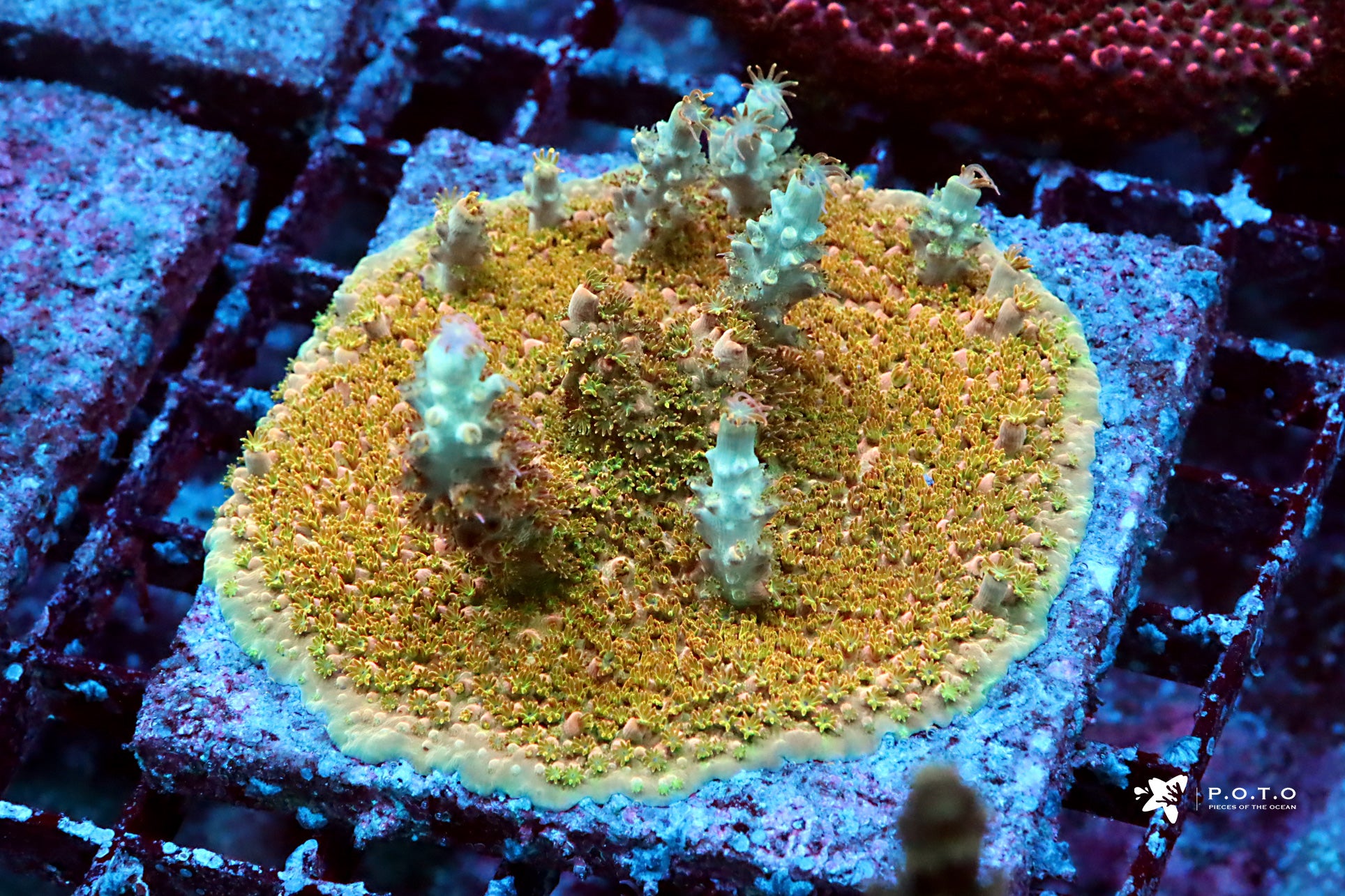
Our experience has shown that a fragged coral that is reduced to a smaller size is quicker to adapt. A larger chunk or a colony that remain intact after going into a new environment takes longer to adapt, with some being more susceptible to STN. It is likely that the old structure of a colony had grown accustomed to its native environment, as it senses drastic changes, it reconsider its growing strategy entirely. The branches may no longer make sense, and its entire body is treated as a base at this point. Growth halts as it acclimates to the new environment. New growth sprouts in locations that are inconsistent with the old shape, but more favorable to survival in the new environment.
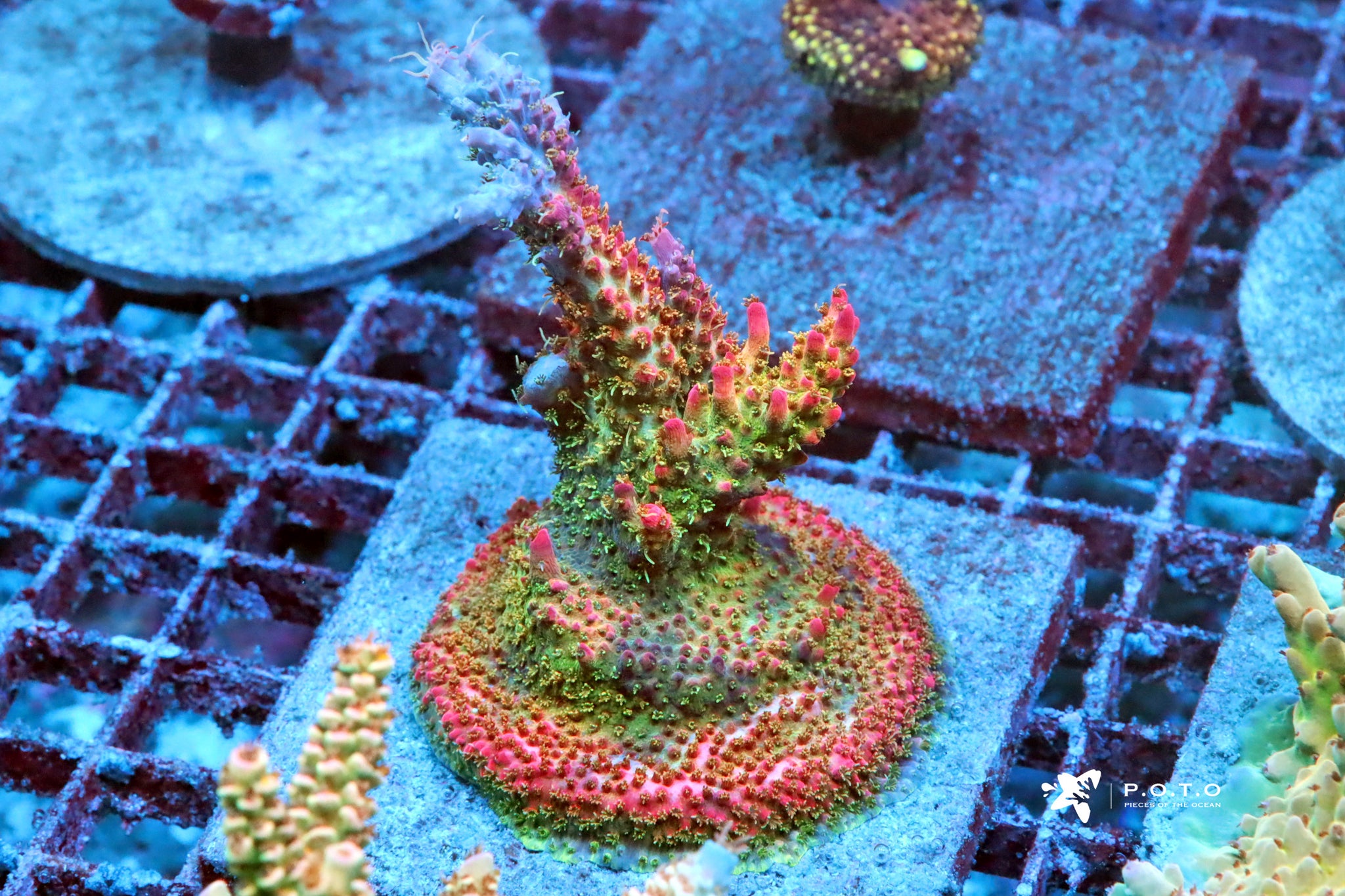
When a coral decides to grow, it does so in a way that is specific to the environment it is in. The flow and lighting pattern, the lighting schedule, nutrient level, and whether there are other corals around, fish-load, bacteria bio-load, etc. Even if there is instability, the coral has gotten used to that too. That environment is unique and cannot be duplicated exactly. Just like no two tanks are alike.
When you put that growing colony in a new environment or tank, it has to adapt to grow all over again based on the new environment. Some adapt better than others. But they all have to re-adapt. The new growth tip from the top may not make sense anymore; or the base is exposed to more light and flow, and may start to shoot out branches. This is common among many acros but especially so in tenuis, millis, and some smooth skin acros. The newly cut frag never continues growing from the growth tip it originally developed before being put in this new environment. More often than not, you will find that it grows branches from the base around the original branch.
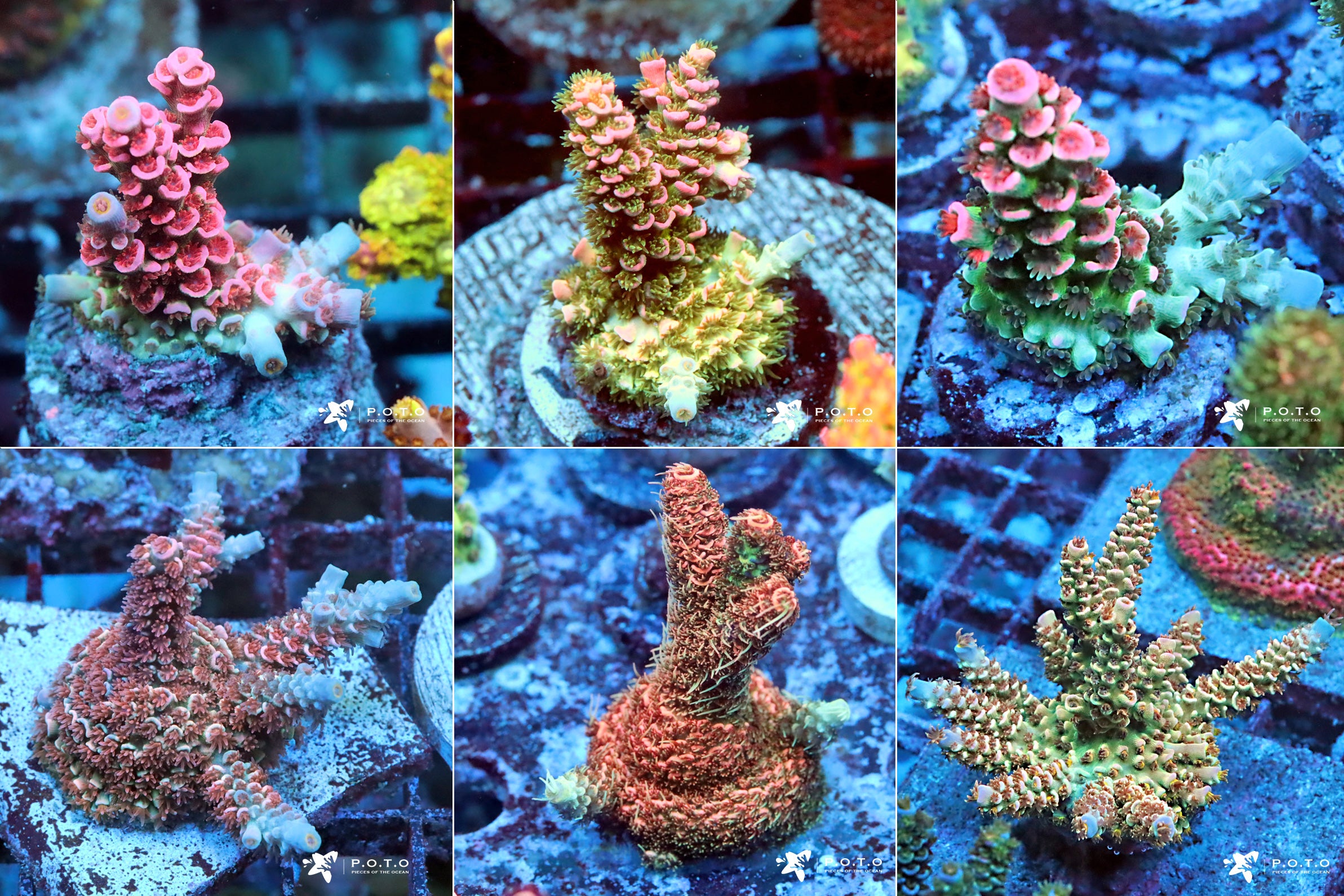
These frags are showing new branches around the old center branch that was in active growth when it was still part of a colony. Those old center branches are no longer actively growing.
Based on these insights, we find great benefits in culturing corals through multiple generations of fragging to give them time to adjust and adapt to the captive environment.
When a coral first arrives at POTO, it goes straight into our receiving systems. Once settled, which can take between 24 hours to 1 week, they receive weekly dipping for up to 4 weeks depending on the circumstances. Longer if pests are suspected. Bases are discarded, after-dip water is scrutinized. Then, a decision is made on whether to put the coral into grow-out or sold as a whole. After all, many hobbyists do seek out larger colonies. If growing out, the coral is fragged into multiple chunks, placed into separate systems for growing. This is F1.
Once the F1's grow and start to render frags, we will take frags from them. These frags are considered F2.
The F2's will grow and as they render frags, we are then confident that these frags will do well in captivity, and offer them up for sale.

The process takes between 6 months to years. Sometimes, the growth shape of the coral no longer resembles that of which when it first came out of the ocean, a sign that it has taken to captivity's environmental factors such as flow and nutrient levels. Colors are brought out under modern LED lighting that were not initially present. The survivability of these captive-grown corals means they are able to endure the stress of transport and variability of parameters better.
It takes time and labor to ensure these corals are captive-grown to the best of their potential, but the end results are tremendously satisfying for us and those fortunate reefers that receive them. Look for captive-grown corals under Our Collection to see for yourself. Happy reefing!
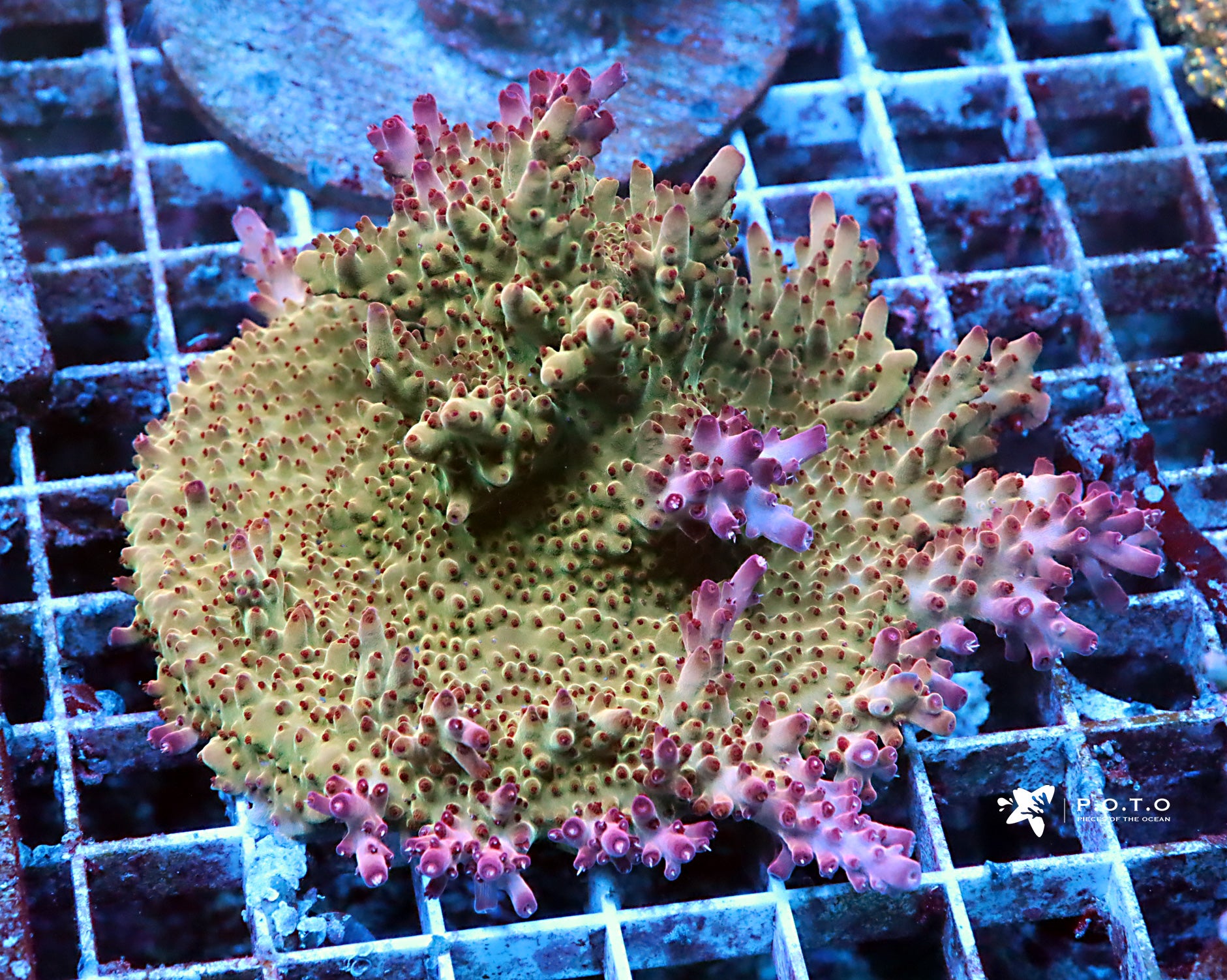
This article focuses on the genus Acropora, as it is the most coveted and demanding coral in the reefing hobby.
Corals lack the meaningful features commonly associated with animals, and are considered a simple life form that is 95% water. This can lead us to downplay the fact that they are in essence animals with complex biological and chemical processes. They can adapt to environmental changes, and can also suffer from them. To understand the concept of captive-growing these creatures, we must first recognize this fact.
Handling and Adaptation of Corals
All corals in the hobby at one point came from the ocean. And when they were first collected, the coral had been living in an environment that remained virtually unchanged over decades if not centuries. Talk about stability.
When a coral is collected, its entire world is turned upside down. It goes through multiple stewardships for days to a week in transport and holding. By the time it gets into a hobbyist's hand, the harshest part is just beginning. They are exposed to dipping, handling and, more often than not, unstable parameters, on top of potential diseases and parasites.
Corals are engineered to survive in harsh conditions by evolution over millions of years. Although the handling and transport can be harsh, if done right, most corals acclimate to captivity well. And it is through this process that corals start to distinguish themselves into categories of hardiness.
Adaptation is a strong characteristic of corals. Have you seen or heard of a coral that sit dormant months and years on end until suddenly it takes off? It is sitting and waiting for favorable conditions before it decides it is safe to grow.

Fragging Helps Growth
Corals can also develop their own personality through fragging and growth. Try taking two frags from the same colony and placing them side by side. Overtime, one can show faster growth than the other. It could be flow, or lighting. They seem to be able to sense very small environmental factors and tweak their growing strategy to them.Our experience has shown that a fragged coral that is reduced to a smaller size is quicker to adapt. A larger chunk or a colony that remain intact after going into a new environment takes longer to adapt, with some being more susceptible to STN. It is likely that the old structure of a colony had grown accustomed to its native environment, as it senses drastic changes, it reconsider its growing strategy entirely. The branches may no longer make sense, and its entire body is treated as a base at this point. Growth halts as it acclimates to the new environment. New growth sprouts in locations that are inconsistent with the old shape, but more favorable to survival in the new environment.

A Coral's Growing Strategy
When a coral decides to grow, it does so in a way that is specific to the environment it is in. The flow and lighting pattern, the lighting schedule, nutrient level, and whether there are other corals around, fish-load, bacteria bio-load, etc. Even if there is instability, the coral has gotten used to that too. That environment is unique and cannot be duplicated exactly. Just like no two tanks are alike.
When you put that growing colony in a new environment or tank, it has to adapt to grow all over again based on the new environment. Some adapt better than others. But they all have to re-adapt. The new growth tip from the top may not make sense anymore; or the base is exposed to more light and flow, and may start to shoot out branches. This is common among many acros but especially so in tenuis, millis, and some smooth skin acros. The newly cut frag never continues growing from the growth tip it originally developed before being put in this new environment. More often than not, you will find that it grows branches from the base around the original branch.

These frags are showing new branches around the old center branch that was in active growth when it was still part of a colony. Those old center branches are no longer actively growing.
Our Growing Strategy
Based on these insights, we find great benefits in culturing corals through multiple generations of fragging to give them time to adjust and adapt to the captive environment.
When a coral first arrives at POTO, it goes straight into our receiving systems. Once settled, which can take between 24 hours to 1 week, they receive weekly dipping for up to 4 weeks depending on the circumstances. Longer if pests are suspected. Bases are discarded, after-dip water is scrutinized. Then, a decision is made on whether to put the coral into grow-out or sold as a whole. After all, many hobbyists do seek out larger colonies. If growing out, the coral is fragged into multiple chunks, placed into separate systems for growing. This is F1.
Once the F1's grow and start to render frags, we will take frags from them. These frags are considered F2.
The F2's will grow and as they render frags, we are then confident that these frags will do well in captivity, and offer them up for sale.

The process takes between 6 months to years. Sometimes, the growth shape of the coral no longer resembles that of which when it first came out of the ocean, a sign that it has taken to captivity's environmental factors such as flow and nutrient levels. Colors are brought out under modern LED lighting that were not initially present. The survivability of these captive-grown corals means they are able to endure the stress of transport and variability of parameters better.
It takes time and labor to ensure these corals are captive-grown to the best of their potential, but the end results are tremendously satisfying for us and those fortunate reefers that receive them. Look for captive-grown corals under Our Collection to see for yourself. Happy reefing!





